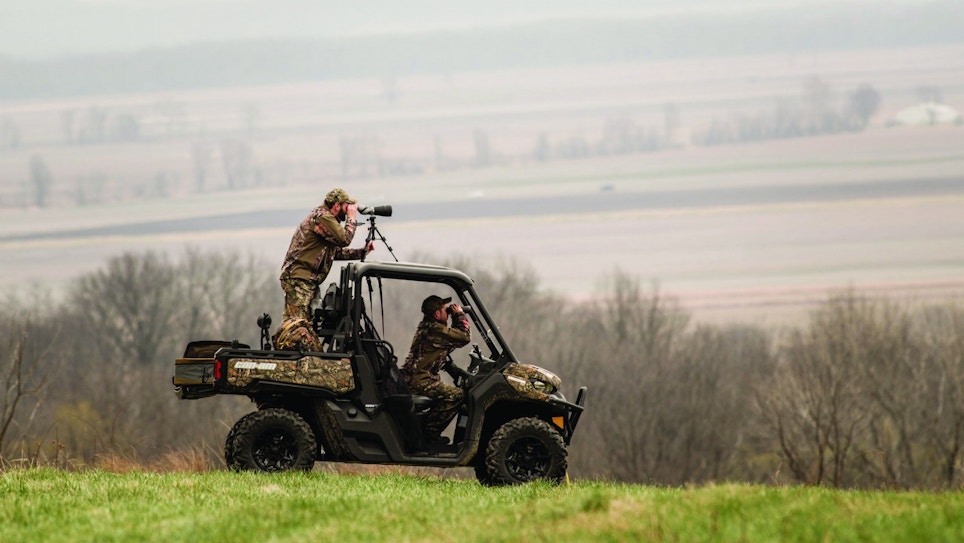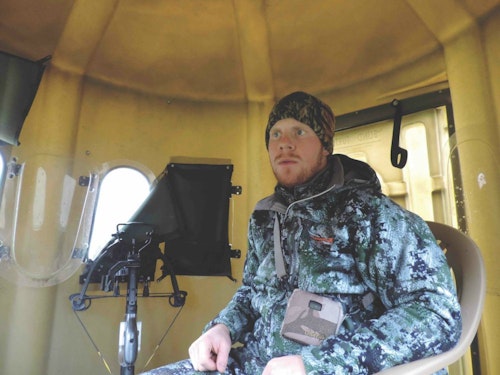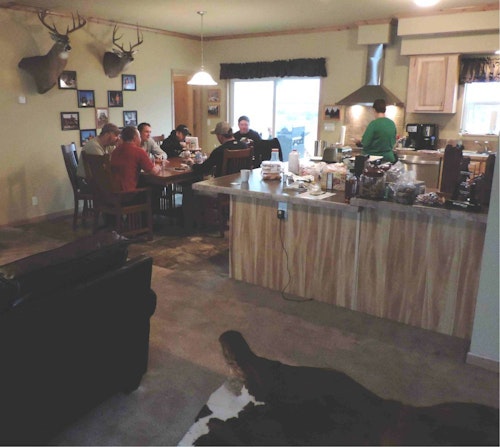
One pro of a fully outfitted hunt is your guide can put you into the action more quickly than you could on your own. A good guide knows the local deer and their habits like the back of his hand because he spends time watching deer daily.
The bone-chilling November mist was sapping warmth from my body as I occupied a treestand overlooking two well-worn trails weaving through a funnel. I hunkered deeper into my camo coat, hood up and hands clutching handwarmers. It was close to 9 a.m., and I had yet to see a whitetail.
Suddenly, commotion south of the stand brought life to my senses. As soon as I grabbed my bow and stood, an obviously hot doe squirted through the funnel, trailed by a mature but broken-racked buck. I gave him a free pass.
That’s when more commotion begged for a southern glance. Sure enough, another buck was trailing up the rear. I had only 20 seconds to deem him a shooter, draw back and make the shot. A quick binocular glance showed me a tall-tined 4x4 frame. I hooked my release into my string loop and brought my Hoyt bow to full draw.
Seconds later, I mouth-grunted to stop him at 27 yards and broadside in my shooting lane. My arrow flashed through the buck just behind his shoulder, and I knew I’d claimed a November prize on day No. 9 of my South Dakota hunt.
That hunt began as a DIY hunt on public land, but when a local outfitter acquaintance learned I was struggling to see mature deer, he offered for me to bowhunt his property. I hadn’t previously hunted with an outfitter, so I didn’t know what to expect. My success came on my fourth sit, and I saw three different shooters during those outings.
Unfortunately, guided hunts don’t always go so well. I’m a DIY hunter through and through, but in my writing profession, opportunities to hunt with outfitters invariably unfold, so I’ve been on a few more guided whitetail hunts, none of which produced bucks. Thus, outfitted hunts aren’t always blissful.
This article aims to help you understand both perspectives of guided whitetail hunts, which will help you make an educated decision of whether going guided is right for you. Let’s dive right in.
Guided Pros
If you want to hunt a new state but don’t know where to begin, there is great merit to hunting with an outfitter. Go with a good one, and they not only know the ground inside and out, but also have done the homework and hung stands for specific winds and to capitalize on the best deer movement.
The benefits of a guided hunt begin as you pack your truck. Leave your blind, stands and climbing sticks home unless the hunt you’ve booked is self-guided on private land where you have flexibility to hang and hunt from your own stands. Packing for a fully guided hunt is far easier than a DIY hunt.
Additionally, good outfitters scout year-round. It’s their job to know what deer roam their land and to formulate game plans for clients to be successful. This includes shed hunting, trail-camera monitoring and glassing. This eliminates the learning curve you’d have on a DIY hunt. It puts you in places where you’ll likely encounter mature bucks. If you go with a great outfitter, you should be hunting ground that holds bucks you’d only dream of encountering on public land. Yes, hunting on prime real estate includes the possibility of shooting your best buck ever.
Meals? Those are typically provided, too. It’s nice to focus solely upon hunting and not have to worry about cooking or cleaning up. Generally, most outfitters also provide portable meals, like sandwiches, that you can take afield. It’s very convenient.
Don’t feel like field-dressing your deer or skinning and boning-out the meat? That’s usually covered, too. In fact, most guides won’t let you get your hands bloody. While you relax in your room or on the lodge sofa, your deer goes from field to freezer.
Guided Cons
This may surprise you, but there is long list of negatives from my perspective.
First, most outfitters run tight ships. What they say goes. And I understand that since they must treat every client — dumb or wise — equally. You know that saying, “Don’t guide the guide?” You’re rarely allowed to choose which stands you hunt from. By booking a fully guided hunt, you usually surrender nearly all of your decision-making freedom. I don’t know about you, but I hate that someone else’s decisions impact my success or failure.

Understand, I’m not knocking outfitters. Many do their jobs well. But, as an independent and self-sufficient hunter, I’ve many times questioned stand placement. I’ve also been placed in stands where the wind was marginal to poor based on where I was told deer would approach from. I’ve occasionally made gentle suggestions, but they usually fall on deaf ears. Basically, you must roll with the punches and hope for the best, which I simply hate.
Many outfitters bait near stands. This could be viewed both negatively and positively. On one hand, deer could come in looking up since other hunters have likely already hunted the stand. They often approach in alert fashion and try to circle downwind. And, the biggest bucks rarely fall for the trap. Conversely, deer that do commit usually present slam-dunk shooting opportunities. You really must know your preferences regarding bait, and then make sure the outfitter in question can accommodate them.

Next, there’s no guarantee of food quality. I’ve hunted with outfitters who provide outstanding meals, as well as one that left me wondering, “Really?” When you pay a lot of money for an outfitted hunt, healthy, great-tasting meals should be a given.
Lodging accommodations also can be causes for concern. I’ve had mostly good, clean and comfortable lodging, but I’ve heard accounts from others that weren’t so glamorous. Also note that other hunters may be in camp for different reasons than you. In other words, you could lose sleep due to the rowdy who insist on drinking and talking loudly well beyond bedtime. I’ve experienced that, and it is incredibly frustrating.

Next, let me note that an outfitted hunt with a reputable outfitter costs $2,000 to $5,000. Most folks who’re loaded don’t think twice, but blue-collar folks should really determine if it’s wiser to get a lease or buy some land instead. If you find this unfeasible, you can inquire with outfitters on your radar about self-guided options. When you’re looking at a hunt that costs thousands, you must ask yourself if it’s worth the money, especially if you’re unsuccessful.
Of course, time limits apply, too. Your $3,500 hunt might get you only 4 or 5 days of hunting. Even on tightly managed properties where hunting pressure is controlled, 4 or 5 days isn’t very long. If the outfitter has done his/her work, you’ll probably get a shot opportunity, but also know that weather might not cooperate. Who knows? Maybe 3 days of your 5-day hunt will be rained out. Now $3,500 seems very expensive, doesn’t it?
Lastly, as if your several-thousand-dollar hunt isn’t expensive enough, tack on travel costs and guide tips. It’s been said that outfitted hunts are for rich people, and if you calculate all expenses involved, you’re ultimately paying a heck of a lot just to have someone provide you with a place to hunt. That’s fine if you have the money but very little time to devote toward scouting/hunting.
Closing Reflections
Perhaps the cons I’ve outlined here don’t scare you a bit or change your perception of what an outfitted hunt can be. Great! But as a final word of caution, ALWAYS check references. Most outfitters will furnish a list of references, but make sure that the list includes both successful and unsuccessful clients.
On the other hand, maybe the cons I’ve listed have opened your eyes up to realities you hadn’t previously considered, and maybe you no longer wish to fork over thousands of dollars. Good news: You can still go and hunt another state on public land. You’ll get to call your own shots, and your moves — not those of an outfitter — will depict your success or failure.
To close, though I prefer to hunt on my own, there are merits to both guided and unguided hunts. You ultimately must decide what’s right for you based on your goals and the experience you hope to have. And if you consider the points I’ve addressed here, you’ll make a better, more educated decision.
Let me leave you with one final story. Before a bowhunt with a South Dakota outfitter, winter storm Atlas threw a wrench into the hunt itinerary. Flights were delayed, and some stands inaccessible. The October blizzard brought heaps of snow that resulted in thousands of dead cattle. Several industry folks and I were going bowhunting!
Obviously, our hunt got a late start, and it also ended early because torrential rains brought on a flooding scare. However, I managed to shoot a doe the first morning on stand, then see multiple bucks on subsequent outings. Only one was a shooter, and he didn’t come anywhere near bow range. Was it a fun hunt? Of course. Was it worth $2,000? Not to me. Whether you go guided or unguided this fall, I hope you make some incredible whitetail memories and put some luscious red meat in the freezer.
Sidebar: DIY Public Land or Trespass Fee?
I love hunting on public land. Hunt as much as you want without knocking on doors or paying expensive outfitter bills. But it isn’t for everyone. If you’re up for a challenge, though, this is it.
Besides ease of access, I love public land hunting because taking a trophy buck means you’ve really accomplished something. In many ways, taking a big buck with an outfitter requires only doing what they say, and then making the shot. I know, it’s not always that easy. But when it is, you’re really just showing up to shoot after they’ve done all the preliminary grunt work.
On a public land hunt, you do the planning. You do the scouting. You learn how to circumvent the pressure imposed by other hunters. You hang the stands and place the blinds. You determine when to hunt each stand. When all those variables align and you take a great buck, that’s the pinnacle for a whitetail hunter.
Now, understand that in most cases you’ll need to adjust your definition of a “trophy” buck when hunting solely on public land. Pressure can be heavy, and buck age class might be weaker than on surrounding private lands where the real big bucks hold down to avoid pressure.
Remember, the biggest buck you can potentially kill is the biggest one in the area. In other words, don’t wait for a 150-inch buck if the area doesn’t produce them.
A word of caution though, public land hunting will test your wits, emotions and mental and physical stamina. And to push through and be successful requires thick skin and perseverance, regardless of what adversity is thrown your way. If that doesn’t fit your personality, then perhaps you’re better suited for an outfitted hunt.
If public land just doesn’t fit your taste, there’s affordable ways to hunt whitetails on private land.
First, some outfitters lease, own or manage private land that is devoted strictly to self-guided hunts. Of course, what happens on these parcels is anyone’s guess, but at least the property limits hunting pressure as compared to public land. And the benefit is that, while the outfitter will (or should) furnish maps and point you in the right direction, you get to make your own choices as to when you hunt and where. If the ground is managed properly, it can deliver the same quality of bucks as a fully guided hunt, but at a substantially reduced rate.
Another viable option is to research properties or knock on doors and gain hunting access via trespass fees. These range in price but are usually even more affordable than a self-guided option through an outfitter.
Top photo courtesy of Howard Communications. Other images by Darron McDougal.







